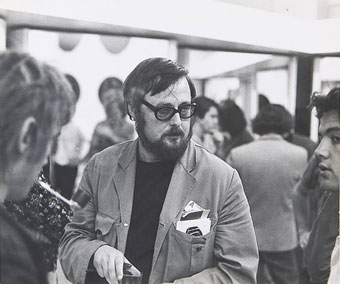1971Harald Szeemann 29 April – 13 May 1971 4 June – 4 July 1971 Download education notes (PDF 7pp) Requires Adobe Acrobat Reader. Visit the Adobe website to download a free copy. It is not a theme but rather as a dimension. We don’t wish to illustrate a style, a theme, but to offer a possible opening: to give connotation, to sustain freedom against barriers erected by styles, nationalities and nationalisms, by the idea of age limits ... as if the age of an artist was a decisive factor for the youth of his work ... To be intensities outside ideologies and stock exchange. L’imagination au pouvoir – to quote a motto from ’68. To celebrate fragility again. Harald Szeemann, 49th Venice Biennale catalogue, 2001, on his choice of title Platea dell'umanita [Plateau of humankind] Szeemann was a prophetic activist in search of visionaries. There are people who have an inexplicable ability to detect subterranean currents of water or (especially in the Alpine countries) crystals and veins of precious ore, and Szeemann was like that –a kind of dowser of artistic energy. He knew he had this gift, and although he was not a significant theoretical writer, he often wrote with great energy and detail about his quest – in diaries, preparatory notes, open letters, and beautifully impulsive catalogue essays and articles. Daniel Birnbaum, ‘Passages’, Artforum International, 22 June 2005 |  Harald Szeemann travelled to Sydney, Adelaide and Melbourne during an intense two-week period in April 1971, visiting museums, galleries and 70 artists’ studio. His exhibition of 22 young artists in Sydney’s Bonython Gallery interior and courtyard and later, with an additional artist, at Melbourne’s National Gallery of Victoria was titled I want to leave a nice well-done child here. It was the first major conceptual show in an Australian museum, and critic James Gleeson in his review for the Sun explained its importance to Australia: ‘it presents the conceptual artist’s point of view as decisively and with as much impact as the now famous Field exhibition’s presentation of abstract minimalism in 1968’ (5 May 1971, p 47). The 22 artists whose works were included in the Sydney exhibition were: John Armstrong, Tony Bishop, Robert Boynes, Gunter Christmann, Tony Coleing, Aleks Danko, Margaret Dodd, Neil Evans, Ross Grounds, Dale Hickey, Tim Johnson, Peter Kennedy, Warren Knight, Nigel Lendon, Ian Milliss, Ti Parks, Mike Parr (who also designed the invitation), Guy Stuart and Alec Tzannes, along with a collaborative work from William Pidgeon, Brett Whiteley and Tony Woods. For Melbourne, a work by Mike Brown was added, while some of the artists created new works for that show. Read more about Harald Szeemann. Harald Szeemann at a ‘meet the artists’ function at John Kaldor’s showroom. Photo: Brian Adams | WORLD EVENTSThe microprocessor – the foundation for today’s computers – is introduced Greenpeace founded Jerzy Kosinski publishes Being there, his satirical novel on TV viewing Hans Haacke’s exhibition about real-estate ownership cancelled by New York’s Guggenheim Museum Artist Chris Burden has himself shot in the arm with a 22-calibre rifle five times for Shoot piece Geoffrey Bardon encourages the Aboriginal people of Papunya to paint a mural and then on canvas, leading to the Papunya Tula art movement 2nd Kaldor project Harald Szeemann curates the exhibition I want to leave a nice well-done child here at Sydney’s Bonython Gallery and Melbourne’s National Gallery of Victoria | ||